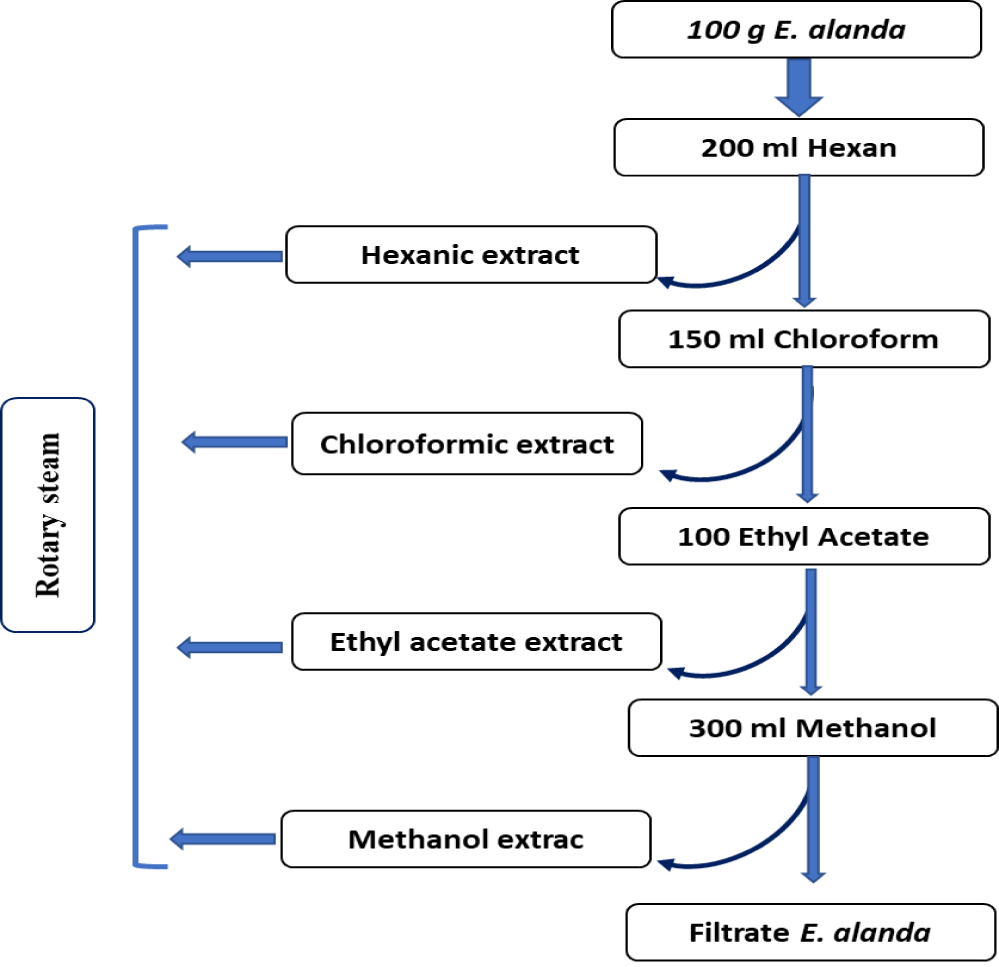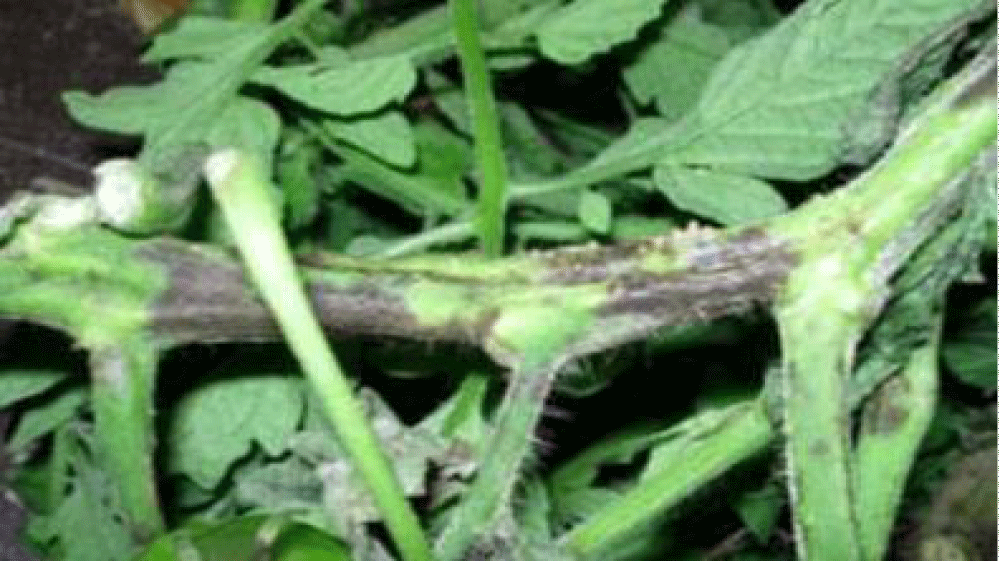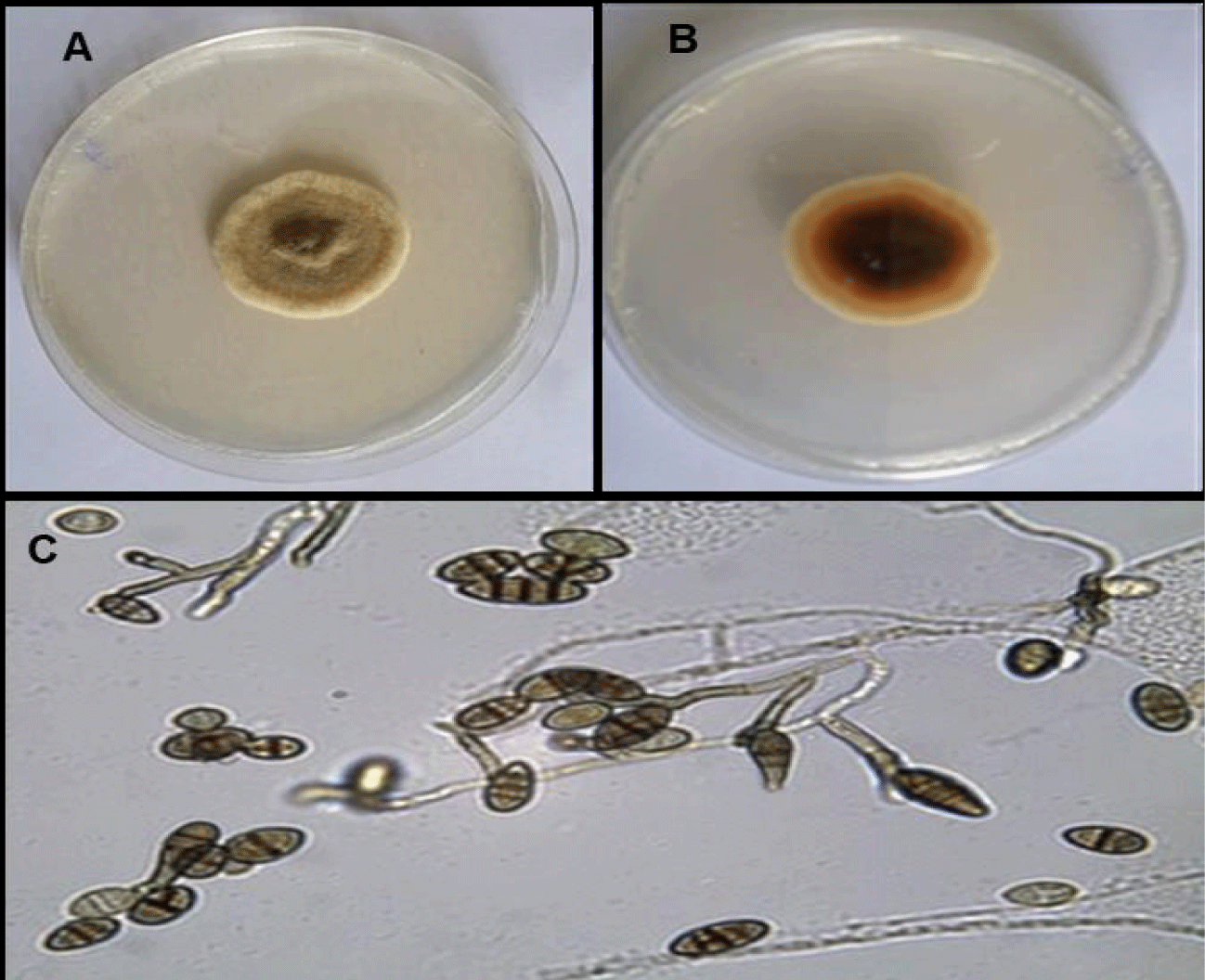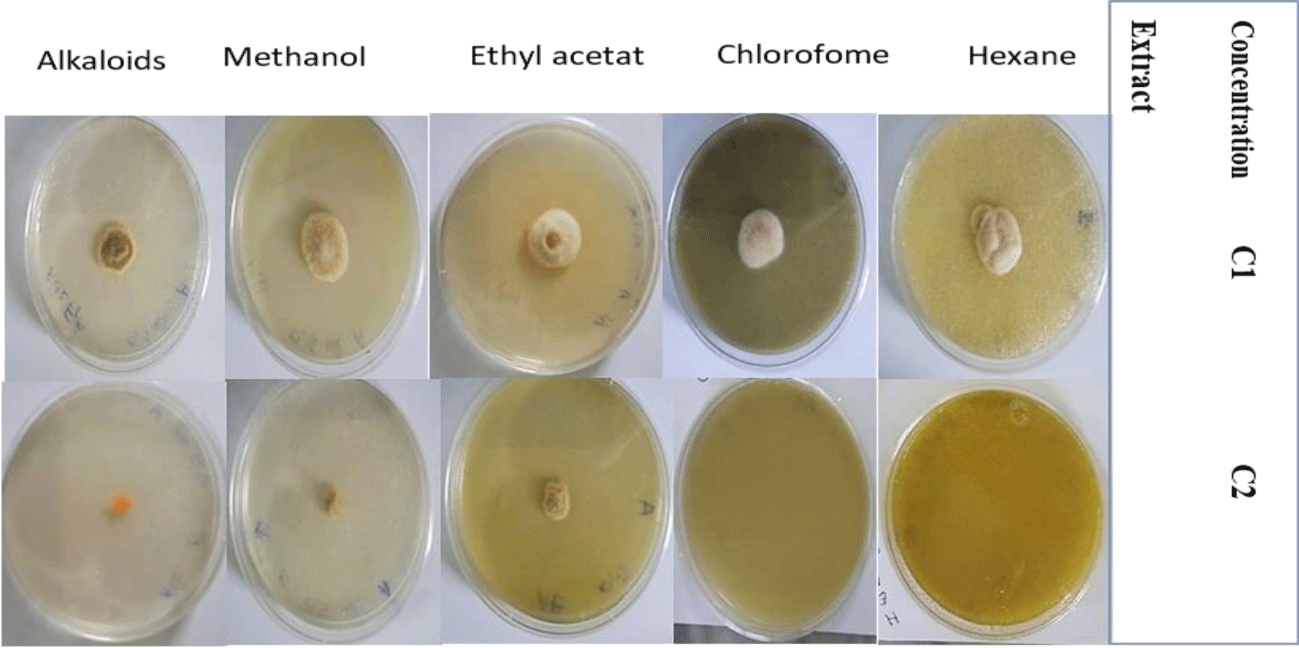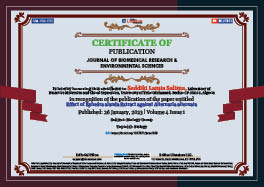Biology Group . 2023 January 26;4(1):098-103. doi: 10.37871/jbres1653.
Effect of Ephedra alanda Extract against Alternaria alternata
Seddiki Lamia Salima1,2*, Attoui Naouel2, Aichaoui Fatiha2 and Terich Chrifa Nour El Houda2
2Faculty of Natural Science and Life, University of Tahri Mohamed, Bechar CP 08000, Algeria
- Ephedra alanda
- Alternaria alternate
- Alkaloids
Abstract
Background: Some fungi have double host attacks for animals and plants, among them Alternaria alternata. Using a local medicinal plant such as Ephedra alanda is one way to fight its spreading.
Aim: Evaluate the effect of the different extracts of Ephedra alanda against the mold Alternaria alternata.
Material and Methods: This work used a different solvent by successive extraction of Ephedra alanda (Hexane, Chloroform, Ethyl acetate, and Methanol) and total alkaloids to evaluate the Anti- Alternaria alternata growth, besides assessing radical scavenging activity used the DPPH.
Result: The result showed a meaningful reduction in the mold's diameter growth. All extracts of E. alanda were effective against A. alternata growth, the concentration of inhibition varied between 5 mg/ml to 14 mg/ml; the total alkaloid was most efficient at a concentration of 0.12 mg/ml. The methanolic extract has an interesting antioxidant activity at 72% of inhibition.
Conclusion: This study showed the ability of different extracts of Ephedra alanda (Hexane, Chloroform, Methanol and Alkaloids) to inhibit the growth of Alternaria alternata in the in-vitro culture.
Introduction
Alternaria alternata is a pathological common fungal belonging to Alternaria genera, it can be saprophytic, endophytic, or pathogenic. The small spores of this pathogen can deteriorate food quality and quantity, and decrease their nutritive profile by releasing some toxic metabolites and hence degrade the economic values of food products and other animal feedstuffs. As a phytopathogen, it can cause severe problems in agriculture by reducing crop yield, thus causing considerable economic losses to farmers and food processing industries [1].
The toxic metabolite released by A. alternata has important clinical relevance to the diagnosis of allergic diseases. Twelve of them fulfilling the criteria of the Allergen Nomenclature Subcommittee of the World Health Organization and the International Union of Societies for Immunology (WHO/IUIS) have been officially listed and numbered from 1 to 15 such: Alt a1; Alt a3; Alt a4; Alt a5; Alt a6; Alt a7; Alt a8; Alt a10; Alt a11; Alt a12 to Alt a13; Alt a4; Alt a15 [http://www.allergen.org]. In previous studies, these allergens have been a source of aggravating asthma, and there is an association between sensitization to Alternaria and life-threatening asthma [2].
To cope with this pathogenic fungus, the use of plants is a struggle way. Ephedra alanda belongs to Ephedraceae family. The local people used it to treat some illnesses. This genus is characterized by the presence of kind of alkaloids such as ephedrine, and pseudoephedrine [3], volatils compound as: α Pinene, αTerpineol, 1,8-Cineole [4], and polyphenol as Epicatechin, Quinic acid, Quercetin-3-o-rhamnoside, they have an antioxidant and the antibacterial activities [5].
Beyond this, there is a lack of publication about the effect of Ephedra alanda against the Alternaria alternata on infecting edible vegetables.
In the present study, we tested the ability of several extract’s Ephedra alanda to inhibit the growth of A. alternata in additional to assess radical scavenging activity was used the DPPH.
Materials and Methods
Plant material
The plant material used the aerial part of the species Ephedra alanda composed of the stem and leaves. The harvest is carried out in February 2019 in the regions of the wilaya of Bechar. After drying, the plant has been ground.
Extraction
The adopted extraction way used is the successive maceration by four solvents; where it used 100 g of the plant material which was defatting by maceration in 200ml of hexane during 24 hours and then exhausted successively by three solvents by increasing polarity: chloroform 150 ml, ethyl acetate 100 ml, as well as methanol 300 ml. The extraction was carried out at room temperature for 24 hours with stirring. After filtration, each extract was concentrated by rotary steam (Figure 1).
Extraction of total alkaloids
The extraction is preceded by defatting, by mixing 20 g of vegetable powder with 100 ml of hexane. After 48 hours of maceration, the mixture was filtered.
The alkaloids are obtained according to the method of [6]; The delipidated powder (10 g) was extracted with a Soxhlet with 300 ml methanol for 8h, followed by evaporating the alcoholic extract obtained, the dried extract was taken up in 50 ml of chloroform acidified with a 5% hydrochloric acid solution at pH = 3.
After 30 minutes, the acidic aqueous solution was made alkaline with ammonia to pH = 9, then placed for extraction of the alkaloids with 50 ml of chloroform in a separating funnel. The chloroform phase recovered and evaporated to dryness. The total alkaloids were recovered with DMSO and stored at 4°C.
Fungal material, extraction, and isolation
Isolation of the fungal: Alternaria alternata was isolated from stem fragments of infected tomatoes (Figure 2). The stems of the tomato plant were cut into small fragments of 2 cm lengthwise; they were disinfected with 2% bleach for 3 minutes to eliminate the saprophytes, followed by several successive rinses with sterile distilled water. Three fragments were placed in Petri dishes containing the PDA medium (PDA Potato Dextrose Agar), the incubation is carried out at 25°C for 5 to 7 days, Bacterial growth was inhibited by the addition of 1 ml of lactic acid to the culture media [7].
Infected tomatoes stem by Alternaria alternate.Purification and identification: After a week of incubation, mycelial filaments appear around small fragments of tomato stems. After primary identification, we perform successive subcultures in new Petri dishes containing PDA acidified medium. To obtain a pure culture by using the simplest and safest process remains that of single spore culture [8].
For identification of the fungal strain, the spores and mycelial filaments were taken by tape adhesive and were placed on a slide added a drop of cotton blue (lactophenol and methylene blue) which makes it possible to swell the mycelium filaments and give better observation [9].
Culture method:
- Micro-culture method: It was carried out according to the method of micro-cultures. It involves inoculating the edges of a small tile with a thin layer of PDAac medium with the spores of the pathogen. The seeded tile was placed on a sterile slide to be covered by a coverslip. The slide was placed in a sterile Petri dish, containing sterile filter paper, soaked in sterile distilled water. After 3 to 4 days of incubation the mycelium was identified by microscopic observation (Figure 2) referring to Barnett's guide [10].
- In-vitro direct contact assay: It was carried out by the method described by Billerbeck V, et al.[11]. The culture medium used for this research is the PDAac medium. Include a different concentration of Ephedra alanda extracts in the culture medium infusion. The final concentrations in the medium were shown in table 1.
| Table 1: Final concentration of E. alanda extract. | |||
| Concentration (mg/ml) | |||
| E.alanda Extract | C1 | C2 | C3 |
| Hexanic | 1.02 | 5.15 | 10.8 |
| Ethyle Acetate | 0.68 | 3.45 | 7 |
| Chloroformic | 2.7 | 14 | 28.6 |
| Methanolic | 1.32 | 6.84 | 14.28 |
| Alkaloïds | 0.099 | 0.07 | 0.12 |
Radical scavenging activity (DPPH)
The antioxidant activity was evaluated using a 2,2-diphenyl-1-picrylhydrazyl (DPPH), followed the method cited by Musa KH, et al. [12]. The DPPH was freshly produced by liquefying 40 mg DPPH in 1000 ml of methanol to obtain a 1.00 ± 0.01 unit of absorbance. The methanolic extract were added at an equal volume (2 ml) to a DPPH solution. After 30 min at room temperature, the absorbance of the plant extract with DPPH was measured at 517 nm.
The absorbance (λ) was converted into the percentage antioxidant activity using the following equation: DPPH ac = (Abl - Asp)*100 where Abl and Asp represent the absorbance of the control and sample, respectively.
Results and Discussion
In plants, Alternaria alternata appears as a phytopathogenic fungus causing various symptoms, black spots, rot, rust, etc. on the different organs of the plant [13].
Identification of fungus
On an acidified PDA medium, the fungi growth showed a greenish-gray mycelium in the center, then yellowing on the front end of the extremity and a whitish perimeter. The reverse of the box is rather a dark brown which takes the degradation of the color from the center to the perimeter.
Under a microscope, A. alternata showed septate filaments and brown macroconidia (dictyospores) rounded at the end and elongated at the other with transverse longitudinal partitions, arranged in a chain (Figure 3).
In vitro anti-fungal assay
The use of different organic solvents successively extracts from the Ephedra alanda have shown great efficiency by inhibiting the A. alternata growth (Table 2, figure 4).
| Table 2: Effect of different solvents extracted from Ephedra alanda each extract solvent had three concentrations of extract added to the media. | |||
| Extract of E. alanda |
Concentration (Table 1) |
A. alternata (mm) diametre |
% Inhibition |
| Control A. alternata | 0 | 26 | -- |
| Hexane | C1 C2 C3 |
17 0 0 |
35% 100% 100% |
| Chloroforme | C1 C2 C3 |
17 0 0 |
35% 100% 100% |
| Ethyl acetate | C1 C2 C3 |
21 15 0 |
19% 42% 100% |
| Methanol | C1 C2 C3 |
21 0 0 |
19% 100% 100% |
| AlKaloids | C1 C2 C3 |
17 8 0 |
35% 69% 100% |
The hexanic, methanolic, ethyl acetate and chloroformic extracts showed total inhibition of growth (100%) at a concentration of 5 mg/ml, 6.8 mg/ml, 7 ml/mg and 14 mg/ml respectively; comparing to control (Table 2, figure 4).
Concerning the total alkaloid, the result showed an important percentage of inhibition at a reduced concentration 0.07 mg/ml (69%) and 0.12 mg/ml (100%).
Looking to the proprieties of each solvent, the hexane may contain more terpenes, ethyl acetate traps the steroids [14], methanol and chloroform may contain polyphenol and flavonoids, saponin [15].
The alkaloids extract from Ephedra alanda, showed an outstanding inhibition of A. alternata. The most known of alkaloids in literature is Ephedrine and Pseudoephedrine [16,17] that suggest, the fungus A.altenaria has a sensibity to Ephedra’s alkaloids, where affect the germination of microconidies, this view is supported by Akroum S, et al. study [18] on this fungus by using several types of plants extracts showed that has been an impact onto germination of microconidia and the growth [18].
Most of the E. alanda extracts showed total inhibition of hyphe growing of A. alternata; it was demonstrated that hydro-methanol of some ephedra species extract contain a phenolic acids, and flavanols like Luteolin-7-O-glucuronide flavone, which have an antimicrobial capacity against Gram-positive and Gram-negative bacteria, and fungi [19,20].
Regarding the antioxidant activity, it was focused only on the methanolic extract, which was shown an interesting activity of radical scavenging activity at 71.67% using the DPPH test, which it was confirmed by Parsaeimehr A, et al. and Dbeibia A, et al. [20,21], whom showed that the methanolic extract of Ephedra alanda has high antioxidant activity.
Conclusion
This study showed the ability of Ephedra alanda extracts to inhibit the growth of A. alternata. However, using the method of the successive extraction by different solvents suggests the presence of compounds able to inhibit the germination of microconidia at different concentrations and the methanolic extract has an interesting antioxidant activity. Therefore, this study needs more clarity about the mechanism of inhibition.
References
- Garg A, Singh S. Alternaria species in aerospora of vegetable and fruit marúet at Agra and their mycotoxigenic potential. Asian J Agric Life Science. 2016;1:4-7.
- Halonen M, Stern DA, Wright AL, Taussig LM, Martinez FD. Alternaria as a major allergen for asthma in children raised in a desert environment. Am J Respir Crit Care Med. 1997 Apr;155(4):1356-61. doi: 10.1164/ajrccm.155.4.9105079. PMID: 9105079.
- Gurley BJ, Wang P, Gardner SF. Ephedrine-type alkaloid content of nutritional supplements containing Ephedra sinica (Ma-huang) as determined by high performance liquid chromatography. J Pharm Sci. 1998 Dec;87(12):1547-53. doi: 10.1021/js9801844. PMID: 10189265.
- Jerbi A, Zehri S, Abdnnabi R, Gharsallah N, Kammoun M. Essential oil composition, free-radical-scavenging and antibacterial effect from stems of Ephedra alata alenda in Tunisia. Journal of Essential Oil Bearing Plants. 2016;19(6):1503-1509. doi: 10.1080/0972060X.2016.1219275.
- Mighri H, Akrout A, Bennour N, Eljeni H, Zammouri T, Neffati M. LC/MS method development for the determination of the phenolic compounds of Tunisian Ephedra alata hydro-methanolic extract and its fractions and evaluation of their antioxidant activities. South African Journal of Botany. 2019;124:102-110. doi: 10.1016/j.sajb.2019.04.029.
- Yubin JI, Miao Y, Bing W, Yao Z. The extraction, separation and purification of alkaloids in the natural medicine. J Chem Pharm Res. 2014;6:338-345.
- Rouxel F, Davet P. Détection Et Isolement Des Champignons Du Sol. France: INRA; 1997. p. 208.
- Choi YW, Hyde KD, Ho WWH. Single spore isolation of fungi. Fungal Diversity. 1999;3:29-38.
- Packer HL, Thomas CR. Morphological measurements on filamentous microorganisms by fully automatic image analysis. Biotechnol Bioeng. 1990 Apr 15;35(9):870-881. doi: 10.1002/bit.260350904. PMID: 18592591.
- Barnett H, Hunter B. Illustrated Genera of Imperfect Fungi. 3rd ed. Minneapolis: Burgess Publishing Co; 1972. p. 241.
- de Billerbeck VG, Roques CG, Bessière JM, Fonvieille JL, Dargent R. Effects of Cymbopogon nardus (L.) W. Watson essential oil on the growth and morphogenesis of Aspergillus niger. Can J Microbiol. 2001 Jan;47(1):9-17. doi: 10.1139/w00-117. PMID: 15049444.
- Musa KH, Abdullah A, Kuswandi B, Hidayat MA. A novel high throughput method based on the DPPH dry reagent array for determination of antioxidant activity. Food Chem. 2013 Dec 15;141(4):4102-6. doi: 10.1016/j.foodchem.2013.06.112. Epub 2013 Jul 3. PMID: 23993591.
- Kim E, Lee HM, Kim YH. Morphogenetic Alterations of Alternaria alternata Exposed to Dicarboximide Fungicide, Iprodione. Plant Pathol J. 2017 Feb;33(1):95-100. doi: 10.5423/PPJ.NT.06.2016.0145. Epub 2017 Feb 1. PMID: 28167893; PMCID: PMC5291403.
- Sudding P, Salempa, Nurhikmah. Isolation and identification of ethyl acetate extract secondary metabolite compound of Kayu Jawa Bark (L. Coromandelica). Journal of Physics: Conference Series. 2022;1899.
- Noui A, Boudiar T, Boulebd H, Gali L, Del Mar Contreras M, Segura-Carretero A, Nieto G, Akkal S. HPLC-DAD-ESI/MS profiles of bioactive compounds, antioxidant and anticholinesterase activities of Ephedra alata subsp. alenda growing in Algeria. Nat Prod Res. 2022 Nov;36(22):5910-5915. doi: 10.1080/14786419.2021.2024184. Epub 2022 Jan 12. PMID: 35019791.
- Hegazi G, El-Lamey T. In vitro production of some phenolic compounds from Ephedra alata Decne. J Appl Environ Biol Sci. 2011;1:158-163.
- Odaguchi H, Hyuga S, Sekine M, Nakamori S, Takemoto H, Huang X, Oshima N, Shimada N, Yang J, Amakura Y, Hyuga M, Uchiyama N, Kobayashi Y, Hakamatsuka T, Goda Y, Hanawa T. [The Adverse Effects of Ephedra Herb and the Safety of Ephedrine Alkaloids-free Ephedra Herb Extract (EFE)]. Yakugaku Zasshi. 2019;139(11):1417-1425. Japanese. doi: 10.1248/yakushi.19-00122. PMID: 31685738.
- Akroum S, Rouibah M. Utilisation d’extraits méthanoliques de plantes pour la protection des cultures de tomates-cerises (Solanum lycopersicum var. cerasiforme) contre l’infection fongique par Alternaria alternata [Protection by some plant methanol extracts of cherry tomatoes (Solanum lycopersicum var. Cerasiforme) from fungic infection by Alternaria alternata]. Biol Aujourdhui. 2020;214(1-2):55-61. French. doi: 10.1051/jbio/2020001. Epub 2020 Aug 10. PMID: 32773030.
- Rustaiyan A, Javidnia K, Farjam M, Mohammadi N. Total phenols, antioxidant potential and antimicrobial activity of the methanolic extracts of Ephedra laristanica. J Med Plants Res. 2011;5:5713-5717.
- Parsaeimehr A, Sargsyan E, Javidnia K. A comparative study of the antibacterial, antifungal and antioxidant activity and total content of phenolic compounds of cell cultures and wild plants of three endemic species of Ephedra. Molecules. 2010 Mar 11;15(3):1668-78. doi: 10.3390/molecules15031668. PMID: 20336006; PMCID: PMC6257367.
- Dbeibia A, Taheur FB, Altammar KA, Haddaji N, Mahdhi A, Amri Z, Mzoughi R, Jabeur C. Control of Staphylococcus aureus methicillin resistant isolated from auricular infections using aqueous and methanolic extracts of Ephedra alata. Saudi J Biol Sci. 2022 Feb;29(2):1021-1028. doi: 10.1016/j.sjbs.2021.09.071. Epub 2021 Oct 1. PMID: 35197771; PMCID: PMC8848002.
- Botton B, Beton A, Fever M, Gaithier S, Guy P, Larpent J. Moisissres utiles et nuisibles impotance industrielle. 2nd ed. France: Masson; 1990. p. 34-428.
Content Alerts
SignUp to our
Content alerts.
 This work is licensed under a Creative Commons Attribution 4.0 International License.
This work is licensed under a Creative Commons Attribution 4.0 International License.





